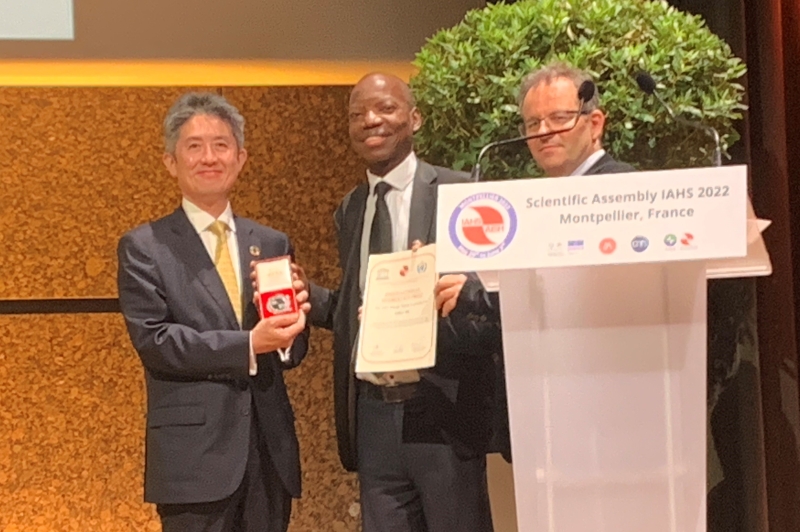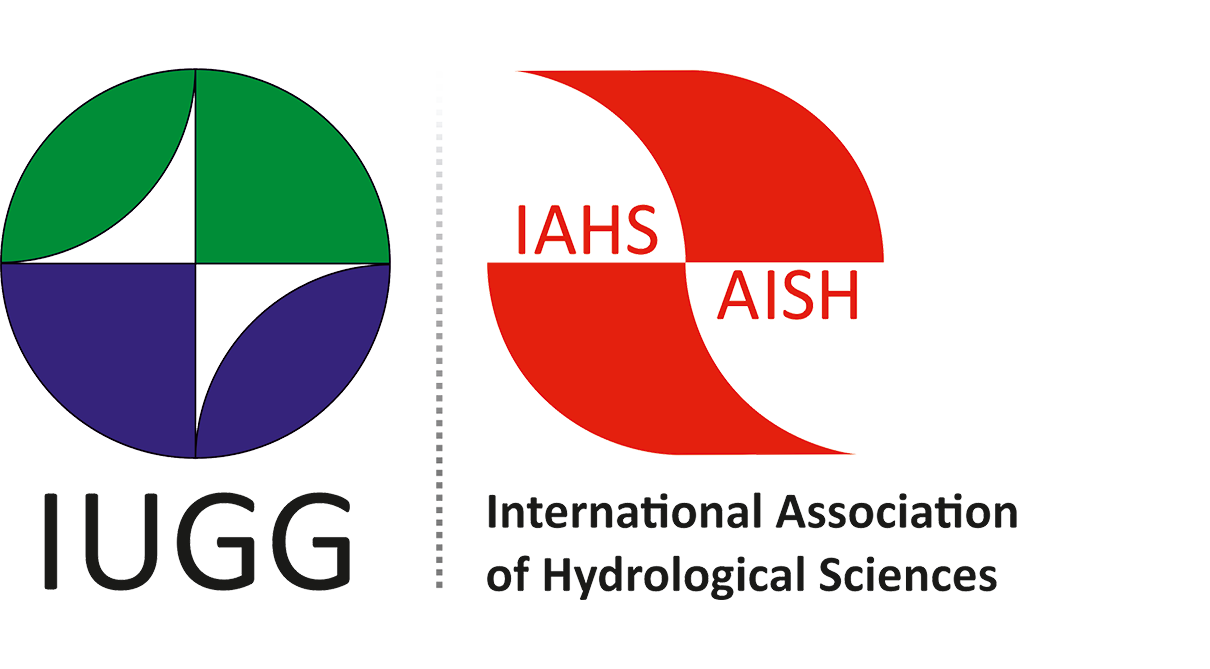Professor Taikan Oki (Japan) is the recipient of the 2021 Dooge Medal (International Hydrology Prize) of IAHS/UNESCO/WMO

Citation for Prof Taikan Oki given by Abou Amani, Director of the division of water sciences, UNESCO
I am delighted to present professor Taikan Oki, as the 2021 recipient of the Dooge Medal. Taikan Oki is Professor of the University Tokyo, Department of Civil Engineering, Graduate School of Engineering and Special Advisor to the President of the University and former Senior Vice-Rector of the United Nations University and former Assistant Secretary-General of the United Nations.
Throughout his more than 30 years of hydrological career, Prof Taikan Oki has contributed to excellence both in science on global terrestrial hydrology, to the promotion of the international scientific cooperation and for linking science and practice in water resource management and climate adaptation through various initiatives and committees. Just to highlight few contributions.
Prof. Taikan Oki has made fundamental contributions to global hydrology since the early 1990s through the development of more than a few novel numerical models and the application of those models by incorporating geographical data and satellite remote-sensing data. Early in his career in 1995, he published a reference paper on global water budget, which was one of the first to demonstrate the potential capability of the atmospheric water balance method to estimate terrestrial water balances in major river basins of the world.
His most wide-reaching work has been in demonstrating the connections between the hydrologic cycle, renewable water resources and the sustainability of society, which is represented by his 2006 paper in Science titled “Global hydrological cycles and world water resources”.
A manifestation of his international leadership in global-scale hydrological modelling has been his co-leadership for the Global Soil Wetness Project 2 (GSWP2) under GEWEX/WCRP which led to estimate the state-of-the-art of the global terrestrial water balance.
Prof. Taikan Oki has long been active on a number of different international scientific fronts. Through IAHS, his pioneering involvement in the Decade on Predictions in Ungauged Basins (PUB), as a member of its Science Steering Group, has led to improve numerical modelling of large-scale hydrology. He also chaired the Hydrology 2020 Working Group of IAHS during 2002-2006, which produced the Red Book published in 2006, documenting the state of global hydrological science and, more importantly by emphasizing the connection between science and water policy, societal issues and interdisciplinary research. This also served as inspiration for the subsequent Panta Rhei Decade.
Prof Oki has made great contribution to the Intergovernmental Panel on climate change (IPCC) in relation to freshwater resources as Coordinator Lead author and lead author. He was also Lead Author for Chapter on "Freshwater Resources", for the Millennium Ecosystem Assessment (MA).
In summary, Prof Taikan Oki is eminently worthy of this International Hydrology Prize. The citation reads “in recognition of his international leadership in hydrological research of scientific excellence and linking science and practice in water resource management and climate adaptation.”
Response by Taikan Oki
Abou, thank you.
Hello everyone.
I am seriously humbled but extremely honoured to receive such a prestigious award like International Hydrology Prize Dooge Medal and to be introduced so generously by Abou, the UNESCO IHP Chair.
I also would like to thank all my respectful friends who took time out of their busy schedules to nominate and support me.
First of all, let me introduce the beginning of my academic career as a global hydrologist.
I was initially fascinated by hydrology during the summer of my junior year at college, when I spent a month as an intern at the Ota River Construction Office in Hiroshima. I had just taken a hydrology course in the summer semester right before, so I worked on an exercise to simulate the intensification of flush floods associated with urbanization using a Kinematic Wave solved with characteristic curves method.
Fortunately, I could manage to simulate or mimic the urbanization and intensification of flooding in Hiroshima City by porting the sample program on a manual written by BASIC language into FORTRAN on an “engineering workstation” and was attracted by the beauty of reproducing complex natural phenomena such as flooding on a computer.
However, when it came time to be assigned to a laboratory for my senior year of college, I wanted to join in the Transportation Laboratory, where a professor had boldly stated that he would "discover Newton's laws of human behavior.”
At that time, rather than designing structures, such as roads, bridges and tunnels, the transportation laboratory was already researching what determines human behavior and how much traffic demand is generated as a result. However, there were five applicants even though only 4 students could be affiliated. After a consultation, we ended up deciding on a rock-paper-scissors, and I lost. Then, I was almost assigned to the Applied Hydraulics Laboratory, which still had vacancies.
However, I had no appetite on hydraulics, so I asked one of my classmates to exchange our positions, and somehow I could be assigned to the River Hydrology Laboratory. If I had not lost the rock-paper-scissors, or if my classmate had not accepted the switch, I would not be here today.
The River Hydrology Laboratory was headed by Prof. Yutaka Takahashi, a winner of IWRA Crystal Drop Award and Japan Prize, but I was practically under the supervision of Dr. Tosio Koike, who had just become a lecturer. At the time, Dr. Koike was working on the development of a distributed snowmelt-runoff model using LANDSAT images to detect the changes in snowpack distribution in mountain areas. Since my advisor was studying snow, I simply decided to study rainfall. I thought that hydrologist from civil engineering should work on rainfall variability, which is one of the fundamental factors causing both floods and droughts.
At that time, radar to measure rainfall distribution was not operational, so I conducted research to classify topographic rainfall distribution patterns based on raingauge dataset and compared them with numerical atmospheric model simulations. However, there was a limit to what one person could do in developing a numerical atmospheric model.
In 1989, the atmospheric general circulation model, GCM, of the Japan Meteorological Agency was transplanted to the University of Tokyo, and I began to participate in its study group in the geophysical institute of the University of Tokyo. Through weekly workshops, in addition to the basic equations, parameterizations, and numerical methods used in GCM, I learned that the typhoons and heavy rains at the end of the rainy season, Baiu, that cause serious flood damages in Japan are part of the Asian monsoon, and that the interannual variations in the Asian monsoon are part of global climatic variations, and I decided to study the global water cycle.
Well, here comes the global hydrology, however, still I am talking about 1989.
I am afraid I am running out of time, so I will tell you the rest of my story the next time I receive such a prestigious award again.
Dear respectful friends, thank you again for your further nominations.
Last but not least, I would like to express my deepest gratitude to all my seniors, colleagues, juniors and students who have taught me many things and dedicated themselves in research with me for the past 30 years. This award is the fruit of our various forms of collaborative research with all of you.
I also want to thank my family for their warmth and support as I turn my back on family gatherings, spend most of my time at home in front of the computer, or go travels and am not home on weekends.
I don't expect this award to make up for all the years of my inadequacies as a husband and father, but thank you so much.
Thank you all, I really appreciate IAHS and I am very happy now.
Thank you.
